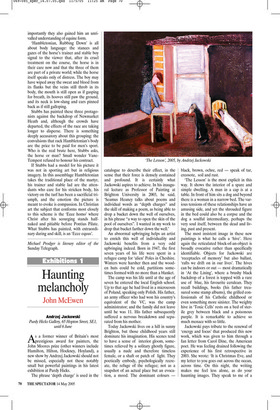Haunting melancholy
John McEwen
Andrzej Jackowski
Purdy Hicks Gallery, 65 Hopton Street, SE1, until 6 June
As a former winner of Britain’s most prestigious award for painters, the John Moores prize (other winners include Hamilton, Hilton, Hockney, Hoyland), a new show by Andrzej Jackowski should not be missed, especially not these notably small but powerful paintings in his latest exhibition at Purdy Hicks.
The phrase ‘depth charge’ is used in the catalogue to describe their effect, in the sense that their force is densely contained and profound. It is certainly what Jackowski aspires to achieve. In his inaugural lecture as Professor of Painting at Brighton University in 2003, he said, ‘Seamus Heaney talks about poems and individual words as “depth charges” and the skill of making a poem, as being able to drop a bucket down the well of ourselves, in his phrase “a way to open the skin of the pool of ourselves”. I wanted in my work to drop that bucket farther down the well.’ An abnormal upbringing helps an artist to enrich this well of individuality and Jackowski benefits from a very odd upbringing indeed. Born in 1947, the first seven years of his life were spent in a refugee camp for ‘alien’ Poles in Cheshire. Winters were harsher then and the wooden huts could be cold, partitions sometimes formed with no more than a blanket.
The camp was his life until at the age of seven he entered the local English school. Up to that age he had lived in a microcosm of Poland, speaking only Polish. His father, an army officer who had won his country’s equivalent of the VC, was the camp administrator; and the family did not leave until he was 11. His father subsequently suffered a nervous breakdown and separated from his mother.
Today Jackowski lives on a hill in sunny Brighton, but those childhood years still dominate his imagination. His scenes tend to have a sense of interior gloom, sometimes relieved by a solitary ghostly figure, usually a nude and therefore timeless female, or a shaft or patch of light. They poetically embody, psychologically recreate, the refuge of the refugee; not as a snapshot of an actual place but an evocation, a mood. The dominant colours — black, brown, ochre, red — speak of tar, creosote, soil and rust.
‘The Lesson’ is the most explicit in this way. It shows the interior of a spare and simple dwelling. A man in a cap is at a table. In front of him sits a dog and beyond there is a woman in a narrow bed. The various tensions of these relationships have an amusing side, and yet the shrouded figure in the bed could also be a corpse and the dog a soulful intermediary, perhaps the very soul itself, between the dead and living, past and present.
The most insistent image in these new paintings is what he calls a ‘hive’. Here again the reticulated block-of-an-object is broadly evocative rather than specifically identifiable. Objects for Jackowski are ‘receptacles of memory’ but also ballast, ‘rafts we drift on in our lives’. The hives can be indoors or out — most dramatically in ‘At the Lining’, where a brushy black backdrop of a forest is topped with a rare use of blue, his favourite cerulean. They recall buildings, books (his father treasured some stamp albums), the grilled confessionals of his Catholic childhood or even something more sinister. The weighty hive in ‘Toxic Cells’ rests on a bed of sterile grey between black and a poisonous purple. It is remarkable to achieve so much menace with so little.
Jackowski pays tribute to the renewal of ‘energy and focus’ that produced this new work, which was given to him through a fan letter from Carol Dine, the American poet. He was feeling drained following the experience of his first retrospective in 2003. She wrote: ‘It is Christmas Eve, and my letter to you goes out across the ocean, across time. On this night, the writing makes me feel less alone, as do your haunting images. They speak to me of a shared grief. What drew me to your art was the feeling I had seen it before, in a dream I could vaguely remember.’ But if Jackowski’s paintings are haunting in their melancholy, they are no less compelling as seductive objects. The colour is rich, the surfaces carefully and sensually modulated. He uses sandpaper to pare down the paint to the canvas, contrasting the sparkling and translucent result with lush passages of brushwork. He subtly animates the meeting of colours to create a jewel-like glow.
We live in an age when the making of art is dictated by the wham-bam-thank-youma’am demands of consumer choice and accessibility. Jackowski’s paintings address us one-to-one and are all the more moving and invigorating for it.



































































 Previous page
Previous page